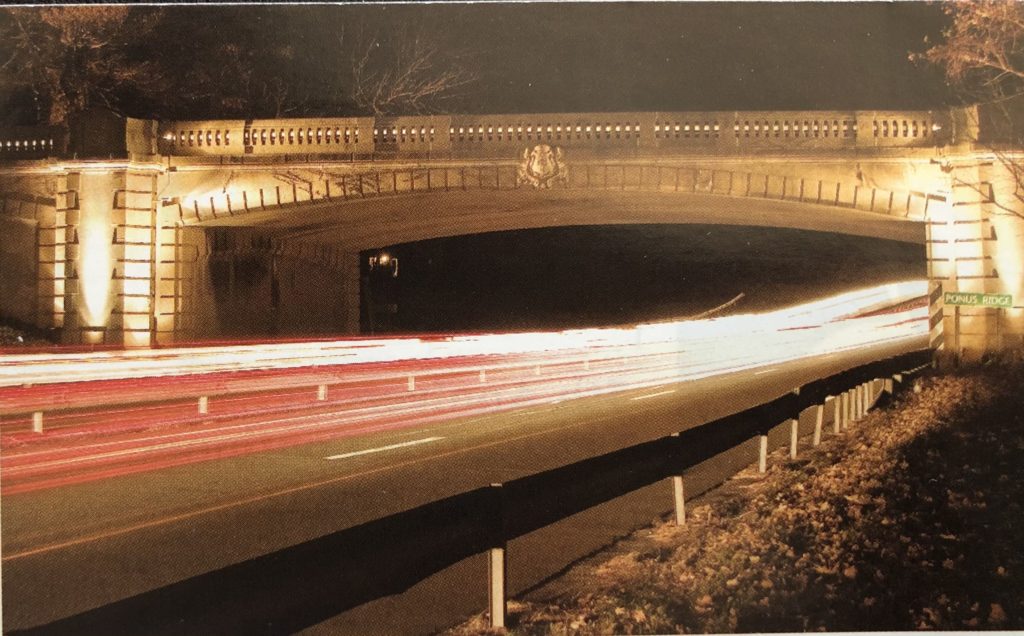By Leigh Grant
(c) Connecticut Explored Inc. SPRING 2008
Subscribe/Buy the Issue!
To drive along the Merritt Parkway in any the season of the year is to be struck by the enduring beauty of New England. The natural landscape on each side of the parkway owes its existence to the parkway’s original 1930s design, to the preservation of the road, bridges, and landscaped park (supported by the parkway’s nomination to the National Register in the 1990s), and to the character of the land that surrounds it.
By contrast, to drive along Interstate 95 is to navigate a truck-laden, asphalt and concrete corridor bordered by signs and buildings. Yet as the Merritt celebrates its 70th birthday this year, the sensibility that values speed over aesthetics is a key factor in alarming changes that are proposed to this scenic road. This same state of mind overlooks the parkway’s vital connecting role in maintaining the Fairfield County greenbelt whose unique character defines this portion of the state.
When Governor Jodi Rell issued her Responsible Growth Initiative in October 2006, the document underscored the ongoing efforts of many of the towns and cities in Fairfield County to address urban sprawl. While transit-oriented development (which concentrates housing density and public transit in urban centers) receives its share of attention, the definition of what should be designated permanent greenbelts—areas containing land with a rural character—remains unclear.
One defining feature that links the greenbelts of Fairfield County is the linear park that surrounds the roadway of the Merritt Parkway that was part of its original design. When the Merritt opened in 1938 and 1940, it connected Connecticut with the New York system of parkways, designed by Robert Moses as radiating pleasure drives from the city to the suburbs.
Congressman Schuyler Merritt, after whom the parkway was named, envisioned it not as a “highway designed and built as a railroad right-of-way” but as a road that “would add beauty to the landscape.” Yet construction of the Merritt brought unanticipated changes.
Today we understand that when roadways are built, they change the land use in the areas they traverse. We know that proximity to highways encourages development. More people mean more vehicles. The Merritt was no exception. After World War II, land values for properties surrounding the parkway escalated, leading to the breaking up of large estates and farms into subdivisions. The countryside evolved into rural suburbia defined by larger residential zones, country clubs, and parks. Redefined by the roadway, today, they constitute the only greenbelt there is.
As pressure to increase traffic capacity on the parkway continues to mount, Merritt Parkway Conservancy becomes more and more important to the parkway’s preservation. The Merritt Parkway Conservancy, the advocate for the Merritt’s historic character, works to keep the “park” in parkway—protecting the landscaped buffer zones from inappropriate access or signage, extra lanes, or office buildings without screening; striving to reduce overblown projects that address super highways rather than limited-access parkways; and stressing adherence to historic guidelines in reference to structures and bridges. All of these issues affect future preservation of this unique greenbelt. What happens to the Merritt Parkway has become symptomatic of whether the megalopolis wins or whether, as in Great Britain, the countryside earns a permanent place outside the city center.
Explore!
The Merritt Parkway Conservancy
“Meet Preservation Connecticut,” Spring 2020
“A Hip Road Trip,” Winter 2009-2010
Read all of our stories about Travel & Transportation by clicking on the category links above.
Read all of our stories about Historic Preservation on our TOPICS page.

